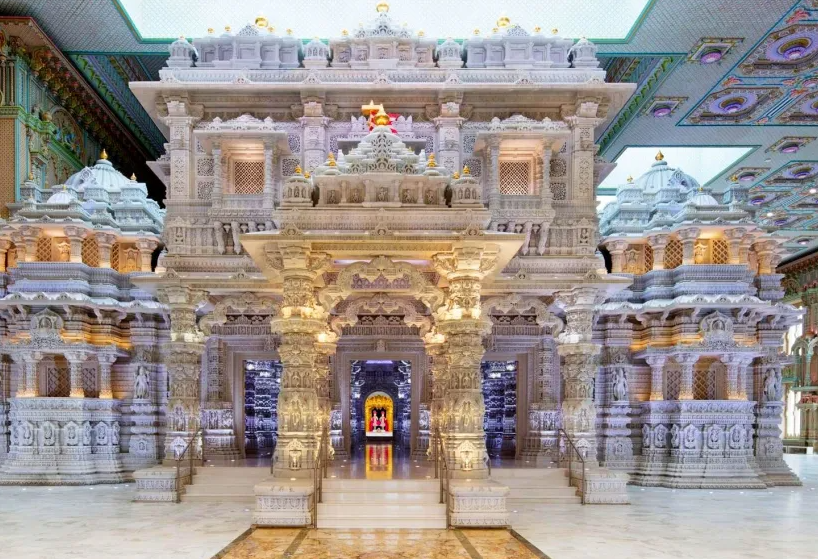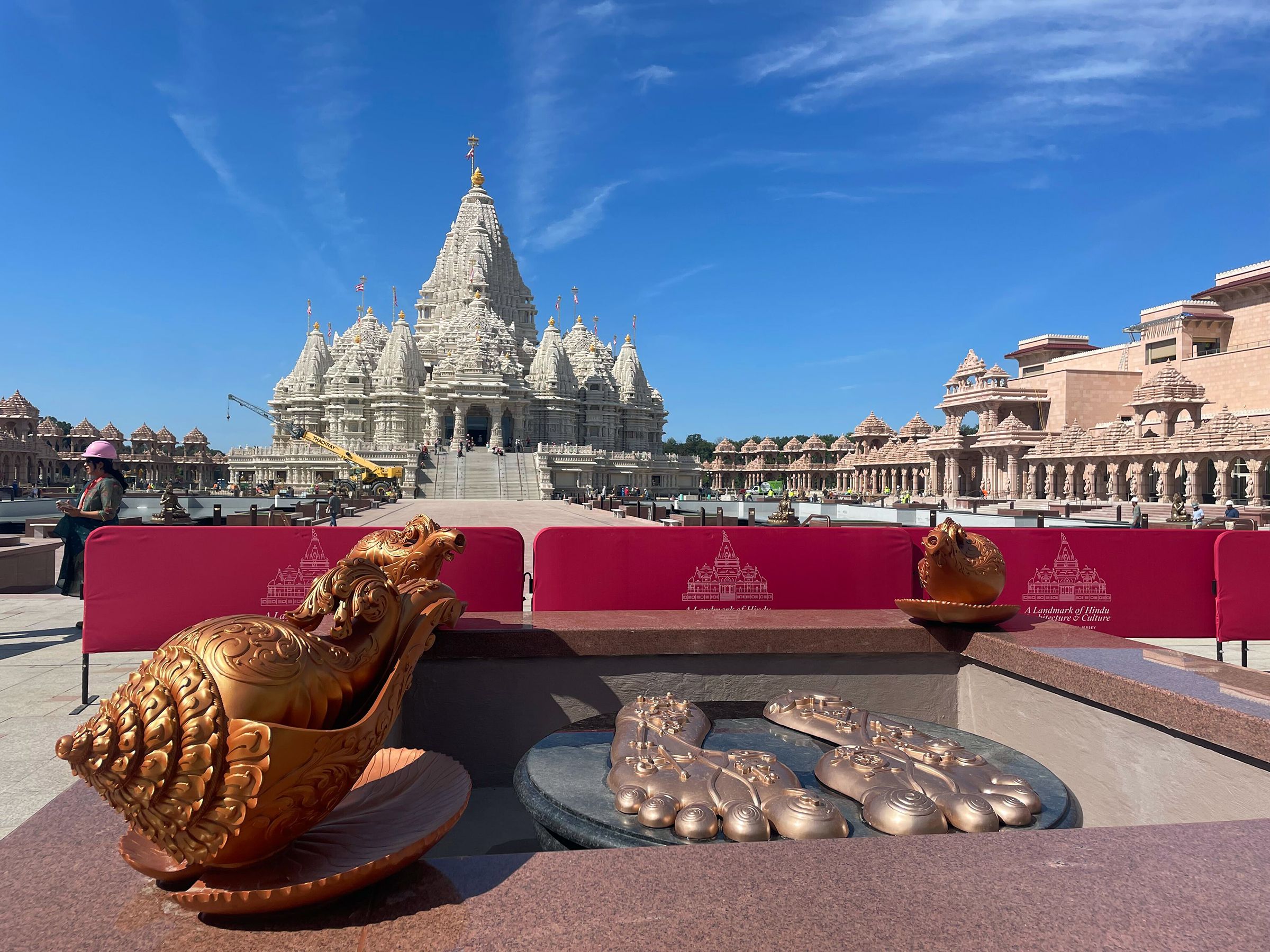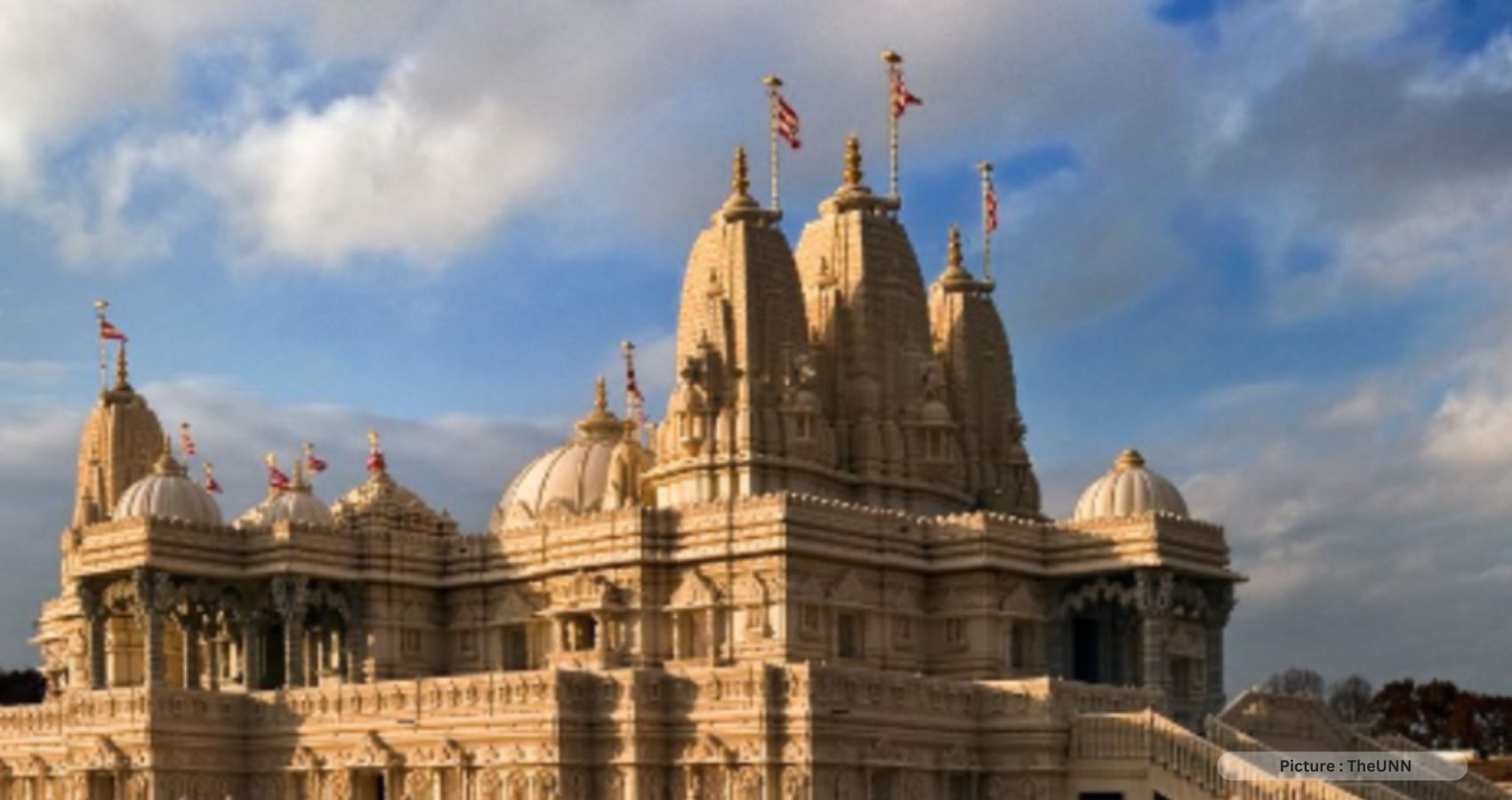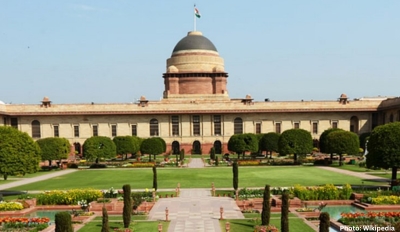After a lengthy period of planning and construction spanning 12 years, the grandest Hindu temple outside of India is poised to open its doors to the public in October. The BAPS Akshardham, located in Robbinsville, New Jersey, will be the third of its kind, following the temples in Gujarat and New Delhi, with the latter being recognized as the largest Hindu temple complex globally.
This architectural marvel, known as Akshardham, which translates to the “abode of the Divine,” is a testament to the harmonious blend of ancient scriptural principles and the intricacies of New Jersey zoning regulations. Sprawling across a vast 183-acre expanse, the New Jersey Akshardham includes a Maha Mandir (main temple), a traditional temple, a welcome center, a museum, and an event space.
Chaitali Inamdar, a devoted member of the Hindu community, expressed the significance of this achievement: “Having this Akshardham here on American soil is not just the triumph of a community or the triumph of the diaspora — it is the triumph of the nation.”
 The construction of the New Jersey Akshardham has garnered significant attention from the Hindu American community over the past decade. However, it has also been marred by legal matters, specifically a lawsuit alleging forced labor within the BAPS organization, which arose in 2021. Although the lawsuit is currently on hold, it has raised important questions about distinguishing between unpaid work and selfless service in the name of the Divine.
The construction of the New Jersey Akshardham has garnered significant attention from the Hindu American community over the past decade. However, it has also been marred by legal matters, specifically a lawsuit alleging forced labor within the BAPS organization, which arose in 2021. Although the lawsuit is currently on hold, it has raised important questions about distinguishing between unpaid work and selfless service in the name of the Divine.
Members of the BAPS community are renowned for their commitment to selfless service, known as “seva,” which they consider an act of devotion to God. Through their seva, BAPS has established an impressive network of 100 temples across the United States. Furthermore, the sampradaya, or Hindu sect, is poised to celebrate its 50th anniversary in North America next year.
Bochasanwasi Shri Akshar Purushottam Swaminarayan Sanstha, commonly referred to as BAPS, is a Hindu tradition that follows the teachings of Bhagwan Swaminarayan. According to their beliefs, Bhagwan Swaminarayan is present on Earth through six spiritual leaders, with Mahant Swami Maharaj currently holding this role.
Devotees explain that Pramukh Swami Maharaj, the fifth spiritual successor, envisioned the creation of a magnificent spiritual campus in the United States when he assumed leadership of BAPS in 1971. Inamdar, a chemical engineer and BAPS member, stated, “Pramukh Swami Maharaj’s ultimate singular vision [was] that, no matter which belief, which background you come from, this place is here to enrich everybody and allow everybody to feel peace and inspiration. The Akshardham is truly allowing the world to be one family.”
Visitors to the New Jersey Akshardham will enter through the Nilkanth Plaza, named after Swaminarayan’s teenage form, Nilkanth Varni, who is said to have traveled across India to revive the principles of Sanātana Dharma, or Hinduism. Dominating the entrance is a towering 49-foot statue of Nilkanth Varni, representing his 49 years on Earth.

The Welcome Center, which connects to the vegetarian Shayona Cafe, immerses visitors in Indian celebrations and artistry. Thousands of “diyas” (lights) adorn the walls, creating a vibrant atmosphere. The scent of incense and the resonance of Sanskrit chants fill the air around the Brahm Kund pond, paying homage to the sacred waters of India. Remarkably, waters from rivers spanning all 50 states have been brought to New Jersey by dedicated volunteers.
Over 12,500 volunteers from diverse cultural backgrounds and faiths came together from across North America and the world to construct the Maha Mandir. This remarkable structure was meticulously crafted from white sandstone, limestone, marble, and granite by temple artisans in India. Adorning the four characteristic domes of the Mandir are nine shikharas or spires, each themed to represent different aspects of Hindu scriptures, including Vedic astrology.
Within the Mandir entrance, statues of dancers, musicians, and musical instruments serve as reminders of the importance of song and dance in Hindu traditions. Notably, this will be the first structure to showcase all 108 poses of the ancient Hindu dance form Bharatanatyam.
Some volunteers dedicated up to two weeks to this monumental project, while others, like 27-year-old Arjun Pandya, felt compelled to stay for two years. Pandya temporarily paused his career in corporate finance at Amazon to undertake seva in Robbinsville. Reflecting on his experience, Pandya said, “To have an opportunity to build something not only for my family and my community, but for the world, and to make something greater than myself, was very attractive.” He acknowledged that the conclusion of this journey is bittersweet, but the invaluable lessons and friendships he’s gained will remain with him forever.
Pandya eloquently summarized his experience: “I thought I’d be giving time, but I’m now realizing how much I’ve gained, not only in the friendships that I’ve built, but the values that are foundational to me that I’ll take with me forever.”
Bhagwan Swaminarayan’s teachings, according to devotees, emphasize values such as humility, compassion, and harmony. Akshardham will serve as not only a residence for the Swamis of the BAPS faith but also a sanctuary for the deities venerated across the broader Hindu spectrum.
Yagnesh Patel, a devotee originally from Kenya, where the BAPS community grew due to Indian migration patterns during British colonial rule, expressed his thoughts. “Any practicing Hindu, anyone who wants to know more about Hinduism, or even just a friend in my community, I have a place to bring them,” he stated. Patel, who was present with his children 12 years ago when BAPS initiated construction in Robbinsville, participated in the Bhumi Pujan ceremony, a tradition involving offering prayers to Mother Earth and God before commencing construction work. His son and daughter, now in their early twenties, have dedicated their time to Akshardham’s construction. “Both my kids are ideal American citizens, born in America, but they can raise their heads and say, ‘I am an American Hindu, and I am so proud that I was part of a place that many can visit as they come to this country,'” Patel proudly declared. “That has been my proudest moment.”
The construction of Akshardham was a challenging 12-year journey for the thousands of volunteers involved, some of whom arrived in the country on R-1 religious visas. They lived and worked on the mandir campus tirelessly. “It’s nonstop seva,” one worker remarked to another in mid-September, just weeks before the opening.
In 2017 and 2022, two devotees lost their lives while working on the construction, reasons the organization attributed to factors unrelated to safety conditions. As recently as March 2023, the Robbinsville Township police department responded to an offsite BAPS housing unit due to elevated levels of carbon monoxide.
In a headline-making event in May 2021, several volunteers originally from India initiated a class-action lawsuit against BAPS, citing wage theft, unsafe working conditions, and mistreatment of workers. However, the laborers withdrew the lawsuit earlier this year.
“The parties agreed to put the lawsuit on hold pending an investigation with which BAPS continues to cooperate fully,” said Ronak Patel, spokesperson for BAPS Temple Organization. “When the facts emerge, BAPS believes that they will reflect BAPS’ principles of kindness, equity, and respect for all human beings. BAPS continues to pray for all involved.”
Regarding the allegations of unpaid labor, BAPS stressed that worship through seva (selfless service) is at the core of the BAPS community, and the workers came to the U.S. as volunteers, not as employees.
“Because BAPS traditions emphasize serving those who serve, we took care of the artisans’ needs in the U.S., including travel, lodging, food, medical care, and internet and pre-paid phone cards so they could stay in touch with their families in India,” Patel added. “BAPS India also supported the artisans’ families in India, so they did not suffer financial hardship as a result of the artisans’ seva in the U.S.”
For many within the BAPS community, the opening in October represents an opportunity to showcase what can happen when devotees from around the world unite through the common thread of devotion.
“The ability to come together in volunteership, in selfless service, it created a sense of comfort and commonality,” expressed Ashini Parikh, a devotee from Atlanta. She reflected on the exponential increase in American awareness of Hinduism since her childhood as a first-generation kid. Playing a role in Hindu American history, for her, is an incredibly humbling experience.
“I am so proud that we as a community can come together from all walks of life, and we’ve all been able to be a part of this one thing that is going to have ripple effects for so many generations to come,” she remarked. “We all want to leave the planet a better place, and my contributions towards Akshardham allows me to leave the planet a better place well beyond my time.”











